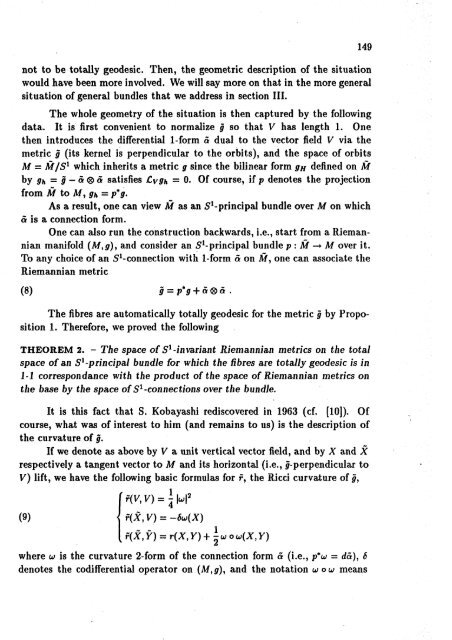Jean-Pierre Bourguignon A MATHEMATICIAN'S VISIT TO KALUZA ...
Jean-Pierre Bourguignon A MATHEMATICIAN'S VISIT TO KALUZA ...
Jean-Pierre Bourguignon A MATHEMATICIAN'S VISIT TO KALUZA ...
You also want an ePaper? Increase the reach of your titles
YUMPU automatically turns print PDFs into web optimized ePapers that Google loves.
not to be totally geodesie. Then, the geometrie description of the situationwould have been more involved. We will say more on that in the more generalsituation of general bundles that we address in section III.The whole geometry of the situation is then captured by the followingdata. It is first convenient to normalize g so that V has length 1. Onethen introduces the differential 1-form a dual to the vector field V via themetric g (its kernel is perpendicular to the orbits), and the space of orbitsM = M/S x which inherits a metric g since the bilinear form gjj defined on Mby g h = g - a ® a satisfìes Cv9h = 0. Of course, if p denotes the projectionfrom M to M, gn = p*g.As a result, one can view M as an S^-principal bundle over M on whicha is a connection form.One can also run the construction backwards, i.e., start from a Riemannianmanifold (M,g) y and consider an S^principal bundle p : M —* M over it.To any choice of an S 1 - connection with 1-form 5 on M, one can associate theRiemannian metric(8) g = p*g + a & .The fibres are automatically totally geodesie for the metric g by Proposition 1. Therefore, we proved the followingTHEOREM 2. - The space of S 1 -invariant Riemannian metrics on the totalspace of an S 1 -principal bundle for which the fibres are totally geodesie is in1-1 correspondance with the product of the space of Riemannian metrics onthe base by the space of S 1 -connections over the bundle.It is this fact that S. Kobayashi rediscovered in 1963 (cf. [10]). Ofcourse, what was of interest to him (and remains to us) is the description ofthe curvature of g.If we denote as above by V a unit vertical vector field, and by X and Xrespectively a tangent vector to M and its horizontal (i.e., «/-perpendicular toV) lift, we have the following basic formulas for r, the Ricci curvature of g,149(9) < f(X 1 V) = -6u 6u(X)[f(X,Y) = r(X,y)+ì W ou;(X } y)2where u is the curvature 2-form of the connection form & (i.e., p*u = rfd), 6denotes the codifferential operator on (M,g) y and the notation wou means














